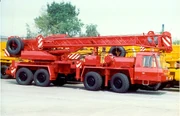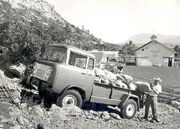The term cab forward refers to various rail and road vehicle designs which place the driver's compartment substantially farther towards the front than is common practice.
Road transport[]
Automobiles[]

The Dodge Intrepid is one of the best known examples of cab forward design in automobiles.

The Tatra 815 has also a version with low cab, which is situated in front of the engine
The first modern mass produced, U.S. automobile design using the cab forward concept was the Pacer, introduced in 1975 by American Motors (AMC).[1][2][3] The company did not call it "cab forward", but the Pacer's layout included wheels pushed to the corners (short overhangs), a relatively wide body, and A-pillars moved forward; the windshield was placed over part of the engine compartment.[4] The cab forward design allowed the passenger area to be much larger than in other similar sized automobiles.[5] The AMC Pacer contained many features, including the “cab forward” design, considered to be ahead of their time and did not enter mainstream automobiles until the 1990s.[6]
In automobile design, the term "cab forward" was used by Chrysler Corporation starting in 1992 to refer to their new Lamborghini Portofino inspired styling and engineering features, similar to those seen on the AMC Pacer, which improved cornering and interior space[7] The passenger cabin was "pushed forward" so that the front wheelwell directly abutted the leading edge of the front doors, and the windshield extended forward near the front axle, while the rear wheels were shifted towards the back corners of the vehicle. Moving the wheels to the edges allowed designers to enlarge the interior while improving ride and cornering. Numerous models built from 1993 to 2004 on the Chrysler LH platform, the JA and JR platforms ("cloud cars"), and the PL platform (Neon), were specifically marketed as cab forward cars. Chrysler claimed to be the first to apply these features to a full-size car.[8]
Commercial vehicles[]
- Main article: Cab over

1957 Kaiser Jeep model FC-170. This heavy-duty Forward Control model was also the first time a pickup box (9 feet with tailgate up) exceeded the wheelbase of a truck.
In road vehicle design, Cab forward, also known as Cab-over, COE (Cab Over Engine), or forward control, is a body style of truck or van that has a vertical front or "flat face", with the cab sitting above the front axle. This truck configuration is currently common among European and Japanese truck manufacturers, because the laws governing overall vehicle lengths are strict and the body style allows longer trailers or a longer cargo area for the same overall length than a standard truck (with an engine compartment ahead of a conventional cabin). Better visibility and maneuverability in tight quarters, such as for city delivery, is a benefit of locating the truck's cab up front. Large trucks of this type are most often described as cab over engine (COE) or cab over models.
References[]
- ↑ Driscoll, Mike. "The pylon points to: Mindi Cross", The Pylon Press, November 2003, retrieved on July 24, 2008.
- ↑ Stakes, Eddie. Response to the posting of Matt Crawford's "Why a Pacer?" essay, "Did the Pacer kill AMC?" undated, retrieved on July 23, 2008.
- ↑ Peter, Eric (2004). Automotive Atrocities: The Cars We Love to Hate. MotorBooks/MBI Publishing Company, 54. ISBN 9780760317877.
- ↑ "Tech Transfer" Okanagan Racing, April 2006, retrieved on July 24, 2008.
- ↑ Mederle, Wolfgang A. "Chapter 1: History" The American Motors Pacer, December 26, 2005, retrieved on July 24, 2008.
- ↑
- ↑ Taras, Jeffrey J. "Driving Smart; What's the Big Deal About 'Cab Forward' Cars?" The New York Times, December 11, 1994, retrieved on July 24, 2008.
- ↑ "Chrysler Defines Cab-Forward and the Second-Generation LH Cars' Styling" allpar,com, undated, retrieved on July 24, 2008.
External links[]
| This page uses some content from Wikipedia. The original article was at Cab forward. The list of authors can be seen in the page history. As with Tractor & Construction Plant Wiki, the text of Wikipedia is available under the Creative Commons by Attribution License and/or GNU Free Documentation License. Please check page history for when the original article was copied to Wikia |